#Miskito People
Photo

Descendientes... . . . #nicaragua #costacaribe #costacaribenorte #miskito #tuapi #indigenous #heritage #culturalheritage #instagood #photography #rural #ruralphotography #people #childrens (at Tuapi) https://www.instagram.com/p/CeHfvV7Olt9/?igshid=NGJjMDIxMWI=
#nicaragua#costacaribe#costacaribenorte#miskito#tuapi#indigenous#heritage#culturalheritage#instagood#photography#rural#ruralphotography#people#childrens
1 note
·
View note
Text
[T]he lands that they reside on [...] are currently under siege from these different extractivist development initiatives.
There are about 46 Garifuna communities along the Caribbean coast of Honduras and on the island of Roatán, and because these are coastal communities located on lands that are highly coveted now for their touristic potential, tourism investors have taken an interest. There’s a lot of land speculation and land-grabbing taking place related to tourism, but also related to agro-industry and agricultural development, specifically African palm. [...]
---
Garifuna have this really complicated history. They are a Black Indigenous people of African, Arawak, and Carib ancestry. They arrived in Honduras in 1797, initially in Roatán, after they were exiled from the island of Saint Vincent. And then from there, they established all these communities along the Caribbean coast of Honduras.
They have been in Honduras since before Honduras gained its independence from Spain in 1823. And I think that’s really significant, because what we see happening is that Garifuna are often positioned as outsiders to Honduras or as recent arrivants. [...]
What is so fundamentally problematic about Garifuna identity [...] for the Honduran state? [...]
There are Garifuna communities in Belize and Nicaragua and Guatemala, and of course, a large Garifuna diaspora in the U.S. [...]
The other point that’s important to mention here is that this sort of exteriorization of Blackness is very much related to Honduran history. So after Honduras gains independence from Spain, like many other countries in Latin America, it is attempting to carve out a unique national identity [...]. It is exclusive of Blackness. Of course, that has all sorts of political and material consequences for Black Hondurans, including the Garifuna, the English-speaking Black population or the Creole population, and even the Miskito population, which also has African ancestry. [...]
---
The development projects that are underway on the Caribbean coast, and that are leading to land dispossession, are projects promoted not just by the state but multilateral institutions like the World Bank and the Inter-American Development Bank. They’re promoted as projects that will create development, that will bring progress and prosperity to Honduras, but often at the expense of Indigenous and Black peoples’ rights. Lands with the largest concentrations of forests, water, white sand beaches, fertile soil — those are largely concentrated in Indigenous and Black territories. So that development or that promise for a more prosperous future is contingent on the extraction of those resources from those communities.
---
Words of Christopher Loperena. As interviewed by the Graduate Center at CUNY. “’The Ends of Paradise’ Explores the Struggles of Honduras’ Black and Indigenous Peoples.” Published by the Office of Communications and Marketing, online in the News section of CUNY’s Graduate Center. 16 March 2023. [Some paragraph breaks and contractions added by me, for accessibility/readability.]
26 notes
·
View notes
Note
Did I miss something about Bernie and gay grooming? Or perhaps I misunderstood what you were saying?
I rewrote that sentence.
For clarity, the Bernie thing is in relation to Daniel Ortega. When the Miskito and Rana people were unwilling to turn over their land to the Nicaraguan government, Ortega unleashed a campaign of bombings and shootings, a policy which is still ongoing as business interests frequently encroach on timber resources and mineral deposits. Sanders continued to raise money for Ortega, and when opposition press published what Ortega was doing, Sanders angrily cut off reporters and compared the opposition press to Nazi newspapers publishing articles on how to kill Jewish people. To Sanders, anti-Native American policies are exclusively an opposition thing. He largely goes uncriticized for his support on this, because for the vast majority of Americans, Native Americans don't exist outside of the United States and Canada.
Sorry for the confusion, Publius.
SomethingLikeALawyer, Hand of the King
14 notes
·
View notes
Text
Separatist and irredentist movements in the world
Mosquito Coast
Proposed state: Communitarian Nation of Moskitia
Region: Mosquito Coast, Honduras and Nicaragua
Ethnic group: Miskitos
Goal: independence
Date: 2002
Political parties: -
Militant organizations/advocacy groups: Indigenous Army of Moskitia
Current status: inactive
History
16th and 17th centuries - attempted Spanish conquest
1630 - the British make the first contact with Mosquito Coast
1631-1641 - Providence Island Company occupation
1638-1787 - Mosquito Kingdom
1740 - Treaty of Friendship and Alliance
1786 - Convention of London
1787-1808 - Spanish occupation
1844-1860 - second Mosquito Kingdom
1860 - Treaty of Managua
1860-1894 - Mosquito Reserve
2002 - first declaration of independence
2009 - second declaration of independence
Europeans failed to settle Mosquito Coast until 1630, when the Providence Island Company arrived. The Mosquito Kingdom was established in 1638 as a British protectorate. During this time, Miskitos conducted raids against Spanish-held territories in the region.
Through the Treaty of Friendship and Alliance, the Miskito Kingdom surrendered its sovereignty to the British Empire. The Convention of London transferred control to the Spanish until they lost rule over Central America in 1821 with the proclamation of the First Mexican Empire.
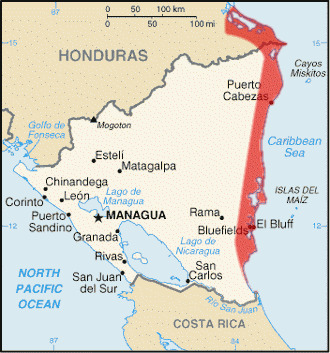
In 1844, a new kingdom under British control was established. The Treaty of Managua transferred suzerainty to Nicaragua, although the latter only annexed Mosquito Coast in 1894. Between these two dates, a Mosquito reserve was established. The Miskitos proclaimed independence in 2002, but no effort was made to achieve it in practice until 2009.
Miskito people
There around 700,000 Miskitos. They traditionally organized in an egalitarian society which transformed into autonomous regional chiefdoms with vaguely defined social classes due to British influence.
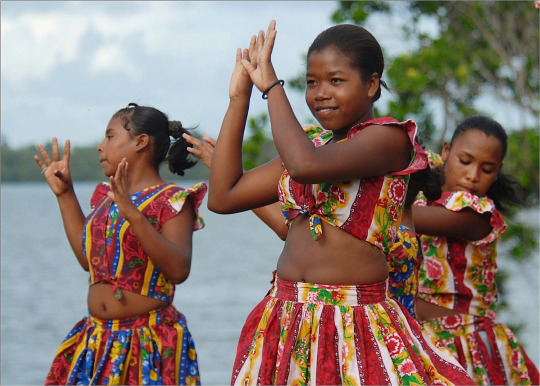
The Miskito people speak Miskito, a Misumalpan language, but also English, Miskito Coast Creole, and Spanish. They practice Christianity but retain some of their traditional animist beliefs.
Vocabulary
(Miskito - Spanish - English)
Miskitu - misquito - Miskito
Miskitu Uplica Nani - pueblo misquito - Miskito people
Miskitu uplikanan - costa de Mosquitos - Mosquito Coast
5 notes
·
View notes
Text
What is the Official Language of Honduras?
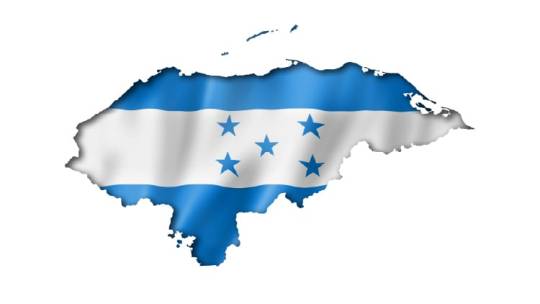
What Languages Do They Speak in Honduras?
The Republic of Honduras is a country in Central America with a population of 9.6 million. The country was home to various Mesoamerican cultures, including Maya. That was, until the Spanish conquest of Honduras which occurred in the 16th century. San Pedro Sula is the second biggest city in Honduras. Although Tegucigalpa is the capital of the country, San Pedro Sula is the industrial center. Income inequality, political strife, and economic instability have been some of the biggest problems that Honduras has been encountering since its independence. The Spaniards brought over the Spanish language to this Central American country. The popularity of Spanish in the Americas has greatly affected the indigenous and regional languages. However, a few indigenous tongues are still spoken in Honduras.
The official language of the country is Honduran Spanish. It is the variety of the Spanish language which is spoken in Honduras. But it is not the only language spoken in Honduras. Popular immigrant languages spoken in the country include Arabic, Turkish, Armenian, and Yue Chinese. Indigenous tongues spoken in Honduras include Ch'orti', Tol, Pech/Paya, Miskito language, and Garifuna language. The Lencan languages lost all of their native speakers in Honduras after the popularity of the Spanish language. But lately, ethnic communities are making attempts to revive these languages. Honduran Sign Language is also used widely by the people of this country.
What is the Official Language of Honduras?
Spanish is the primary and official language of Honduras, spoken by the majority of its population. Additionally, English is commonly used, particularly in regions such as the Bay Islands. While Spanish is the dominant language, Honduras is also home to a diverse linguistic landscape, with indigenous languages like Ch’orti’, Tol, Pech/Paya, Miskito, and Garifuna being spoken by certain communities. Efforts are underway to preserve and revive these indigenous languages, alongside the widespread use of Honduran Sign Language
Castilian, also known as Spanish, is the Romance language that is spoken by almost everyone in the Republic of Honduras. It is also the official language of the country. It has different names in the country including Honduran Spanish and Castilian. It is used for official purposes by the government of Honduras. It is an important part of the identity of the Honduran population. For them, their language is an inseparable part of their culture and must be valued in every walk of life.
All over Latin America, Spanish became popular because of colonization. Today, it enjoys official status in over twenty countries and is one of the most spoken languages in the world. But whenever a foreign language becomes popular, it affects the mother tongues of the minority communities. This is why many indigenous languages in the Americas ended up becoming extinct after the Spanish colonization.
English to Honduran Translation:
If you are planning to visit Honduras or you want to expand your business into that country, you will have to get a lot of documents translated into the Honduras language. If you are planning to visit Honduras from the US, your documents like birth certificate will be in English. But they must be translated into the Honduran Spanish so the authorities can check them easily.
When a company from the United States wants to expand its operations to Honduras, it will also require English to Honduran translation. Although there are many languages of Honduras, Spanish is the one which is preferred by the state and the people of the country. Only with the Honduran translations can you connect with your target audience.
But the Spanish in Honduras is different from the variety of the language which is spoken in Spanish. It is also different from the Spanish of El Salvador. As a result, you need the help of a native translator so you can get accurate results in the Honduran Spanish. The schools in Honduras teach Spanish to all the students in an academic manner, which is why you can rely on native experts without any hesitation. They will not only know the language thoroughly but will also be familiar with slang terms and Honduran culture. So, if you hire a native expert, connecting with your target market will become easier.
We have experts in all the Latin American languages on our team. Whether you want to reach out to people of urban centers or you want to connect with rural areas, we will make sure you get the help of the right linguistic expert. A language expert should not only have a high level of English skills, but they should also know the Honduran language completely. We will make sure you get accurate English translations that you can use for your business without hesitation.
Facts About Honduras Language:
Here are some interesting facts about Spanish Honduras:
The Spanish Empire:
It was during the colonial period that the people of Honduras begin adopting this new vernacular. It affected their indigenous languages. Slowly, the Spanish of Honduras became the most popular language in the country. The other vernaculars, including the Mayan languages, slowly faded into the background.
Importance by the State:
Honduras is given the most importance by the Honduran government. It is used for official purposes all over the country. Despite the various popular tongues which are spoken in the rural areas, it is Spanish which is used widely. It is the primary language in all the governmental organizations.
Influence:
Immigrant languages like Arabic and Turkish have influenced the Honduran variety of Spanish. Indigenous languages also affected the dominant language of Honduras. This has made the variety of Spanish spoken in Honduras quite different from other Central American and Caribbean languages.
Common Slang Words:
The slang terms used by the Honduran people are an important part of their vernacular. These slang terms are also used in El Salvador and other neighboring states of Honduras.
English Translations:
Spanish to English translations are quite common in Latin America. People who want to immigrate to the United States from one of these countries need the help of linguistic experts for the translation of their documents. Authorities in the United States only accept foreign language documents when they are accompanied by certified translations. But since Honduras has a unique variety of Spanish, the language can only be translated into English by qualified experts. You can only get through the immigration of the United States if you have accurate English translations of your documents.
How to Learn the Honduras Language?
If you are planning to move to the Republic of Honduras and want to learn the native language, then you don't have to worry about anything. There are various schools in the country that teach Spanish. You can also hire an individual teacher to teach you the native language. The diverse classrooms will help you feel at ease. Professional growth in the Republic of Honduras will become possible once you have learned Spanish. Native English speakers are valued highly in the Republic of Honduras. If you know the English language, you can easily make professional growth by teaching it to the natives. The Hondurans would happily accept you as a part of their community. You don't even have to learn all the languages of Honduras to become one of them. Whether you want to live in San Pedro Sula or any other part of the country, being fluent in both English and Spanish will be very helpful for you.
Read the full article
0 notes
Text
InSight Crime's investigative report, titled Moskitia: the Honduran Jungle Drowning in Cocaine, has been awarded the Ortega and Gasset Award for Best Story or Journalistic Investigation 2023. Written by Juan José Martínez and Bryan Avelar, the report delves into the impact of drug trafficking in the Moskitia region of Honduras, where violent land grabs by individuals linked to criminal groups are displacing indigenous populations. The series sheds light on the struggles of the Miskito people as they fight for survival amidst the destruction of their pristine ecosystem.
The jury praised the report for its comprehensive coverage of important contemporary issues such as drug trafficking, environmental destruction, and the endangerment of ancestral cultures. They noted that the report provides a detailed insight into the daily life of a region ravaged by drugs and neglected by governmental institutions. The report offers a poignant portrayal of the devastating effects of drug trafficking on both the environment and the indigenous communities who call the Moskitia region home.
The investigative series offers a firsthand account of the impact of drug trafficking on the lives of the Miskito people, showcasing the struggles they face in the face of violent land grabs and displacement. The report also highlights the role of criminal groups in exploiting the region's natural resources for profit, leading to the destruction of a unique and irreplaceable ecosystem. Through the stories of those directly affected by drug trafficking in Moskitia, the report sheds light on the human cost of the drug trade in Honduras.
In light of the ongoing challenges faced by the Miskito people and other indigenous communities in the region, the investigative report serves as a call to action for authorities and organizations to address the root causes of drug trafficking and its impact on vulnerable populations. By raising awareness of the devastating consequences of drug trafficking in the Moskitia region, the report aims to spur positive change and advocate for better protection of indigenous rights and environmental conservation efforts in Honduras. Through its in-depth reporting and powerful storytelling, the series aims to spark dialogue and encourage action to address the complex issues plaguing the region.
In conclusion, InSight Crime's award-winning investigation Moskitia: the Honduran Jungle Drowning in Cocaine sheds light on the interconnected issues of drug trafficking, environmental destruction, and the displacement of indigenous populations in the Moskitia region of Honduras. By providing a comprehensive analysis of these pressing issues, the report serves as a powerful tool for raising awareness, inspiring action, and advocating for change. The report captures the human stories behind the headlines, offering a nuanced perspective on the impact of drug trafficking on the lives of those most affected. Through its meticulous research and compelling storytelling, the report provides valuable insights into the complex challenges facing the region and underscores the urgent need for collective action to address these pressing issues.
0 notes
Text
A people without its language is like a bell without its tongue – silent: let us preserve Indigenous.
Today, according to the UN, there are about 6 000 languages globally, and 43% of them are endangered. Only a few hundred languages play a prominent role in education systems and in the public sector, and less than a hundred languages are used in the digital domain.
Languages play a crucial role in preserving identity of a person, groups of people and ensuring their peaceful coexistence. They serve as one of the strategic factors in making progress towards sustainable development and harmonious relationships at the global and local levels. Every year, by decision of the General Conference of UNESCO, 21 February is celebrated as International Mother Language Day.
How it all began
Following the designation of this International Day, the UN has increased its efforts to draw attention to language endangerment. In 2007, the UN General Assembly proclaimed 2008 the International Year of Languages, and on 19 December 2016, declared 2019 the International Year of Indigenous Languages to point out the pressing issue of the loss of such languages and the need to preserve and revive them, as well as encourage their study and mastery.
Finally, on 18 December 2019, the UN General Assembly proclaimed the period from 2022 to 2032 the International Decade of Indigenous Languages to draw global attention to the plight of many Indigenous languages and mobilize stakeholders and resources to preserve, revive and promote them.
FAO and Indigenous languages
FAO has six official languages. In the framework of the International Decade of Indigenous Languages, the FAO Indigenous Peoples Unit is translating one of the organization’s founding documents, the Voluntary Guidelines on the Responsible Governance of Tenure of Land, Fisheries and Forests in the Context of National Food Security, into different Indigenous languages. These Voluntary Guidelines are the first comprehensive global legal instrument on this subject, resulting from intergovernmental negotiations.
The document is currently available in 22 languages including Nepali, Miskito, Hindi, Albanian, Indonesian, Laothian and Amharic. In December 2022, FAO launched the VGGT translation in Sadri and Kurukh, Indigenous languages mainly spoken in India.
The Decade of Indigenous Languages in Russia
On 14 February 2022, the Government of the Russian Federation approved the action plan (in Russian) for the International Decade of Indigenous Languages.
In total, the plan provides for more than 60 events, which are divided into six thematic sections dedicated to improving public administration, education and teacher training, science, digitalization and book publishing. In particular, it is planned to develop keyboard layouts, fonts and mobile applications in national languages, create a virtual museum of the traditional culture of the Indigenous small-numbered Peoples of Siberia and the Far East, conduct tours of theater troupes and other events.
The All-Russian Ethno-Dictation in the Indigenous languages, which took place on 18 February 2022, gave birth to the Decade in Russia.
According to the Federal Agency for Ethnic Affairs of the Russian Federation (FADN) (in Russian), some of the events of the plan will be held regularly. For example, an international conference dedicated to the preservation of Indigenous languages will take place every two years. The All-Russian Congress of Teachers of the Native Language and Literature of the Indigenous Peoples of the North, Siberia and the Far East will be held every three years. Annually, the Ministry of Education and Science of Russia and the Institute of Linguistics of the Russian Academy of Sciences will conduct research on the sociolinguistic situation of Indigenous languages and scientific research on specific topics.
Projects for the preservation of Indigenous languages in Russia
Here are some examples of projects aimed at preserving Indigenous languages of Russia:
The project "Digitalization of the linguistic and cultural heritage of the Indigenous Peoples of the Arctic" of the UNESCO Department of the Northeastern Federal University named after M.K. Ammosov. The project also collects information about Indigenous languages, recorded and published native languages TV lessons (the Yukaghir, Even, Evenk, Chukchi, and Dolgan languages), as well as other educational materials.
The "Minority Languages of Russia" (in Russian) website, based on the Laboratory of Study and Preservation of Minority Languages of the Institute of Linguistics of the Russian Academy of Sciences, is a publicly accessible Internet information resource containing materials on the structure and use of minority languages of Russia and their local variants. The current version of the site presents materials on 162 Indigenous languages of Russia. The site provides the following information about each language: genealogy, distribution area, number of native speakers, language functioning, development dynamics, etc.
The interactive atlas of the Indigenous Peoples of the North, Siberia and the Far East: Languages and Cultures (in Russian) makes you discover the culture, languages, traditions, but first and foremost, the outstanding Indigenous representatives. In the atlas, in addition to historical references, general and ethnographic information, you can find lists of fiction in the language spoken by a particular people, and watch / listen to recordings of native speakers in the media library (in Russian).
The KMNSOYUZ language portal (in Russian) publishes news about Indigenous languages. Special attention is paid to the section devoted to the digital practice of Indigenous languages (in Russian) with links to mobile applications for learning native languages and online translators, and a media library (in Russian) that contains links to cartoons, clips, audio stories and podcasts in Indigenous languages.
Children of the Arctic. This information and educational portal is designed to navigate throught the Indigenous Peoples of the North that live in the Arctic zone of the Russian Federation. Special attention should be paid to the YouTube project channel (in Russian), which publishes monologues of famous representatives of the Peoples of the Arctic (in Russian), i.e. philologists, craftsmen, and artists, about their lives, work, and traditions; karaoke of the Peoples of the Arctic,as well as language courses (in Russian) and cartoons.
#mother tongue#FAO#indigenous languages#International Decade of Indigenous Languages#21 february#international mother language day
0 notes
Text
Miskito Cay
Miskito Cay
It's a huge wolf most likely werewolves I was not aware that they were entombed.
Zues Hera
We've had several sightings out there of werewolves and yeah that's where they are and South America is known for them. He's searching for the island it's in the movie picture clip voices by Mr Ballard and it's a strange song but it's actually very intense just trying to figure out what shape it's in it's rust Ballard and we will have to try and direct them towards the website it's an intense moment to find things like this for him and he and I mean the wolf but it's much more intense when he figures out what the island is he thinks it's a key which probably has it's something much bigger and in importance
Bitol and Goddess Wife
We are launching tons of lawsuits today against a lot of you people and you will be surprised too no the guy next door is so damned abusive he should have to be in court 24 hours a day
0 notes
Text

A scarlet macaw perches on a tree branch at sunrise with the full moon in the background in La Mosquitia, Honduras. The region is home to the largest wilderness area in Central America and is the only place in the country where these birds fly freely. The national bird of Honduras had been at risk of extinction but the population has rebounded thanks to conservation efforts supported by the Indigenous Miskito people.
This Bird’s Protectors Are Its Former Hunters: ‘It Was My Turn To Help Them’
The scarlet macaw population in Central America’s largest wilderness area had dwindled drastically. The Indigenous Miskito people stepped in to help save them.
— By Jorge Rodríguez | February 6, 2023 | Photographs By Alejandro Cegarra
La Mosquitia, Honduras — It's 4:30 in the morning. Behind a pine forest, the sun begins to lighten the sky with bright and warm tones, accompanied by the squawks of a small group of apu pauni, as the Indigenous Miskito people call the scarlet macaw. The colorful feathered creatures, the country’s national bird, groom each other as they wait for Anayda Pantin Lopez who has dedicated the last 12 years to protecting them.
"I do it with lots of love because they are like my children,” says Pantin. “I give them rice with beans, yucca, and plantain. When we can, we buy bird food."
The Miskitos live in La Mosquitia on the northeast corner of Honduras, which has the largest wilderness area in Central America and is the only place in the country where scarlet macaws fly freely. Pantin and her husband, Santiago Lacuth Montoya, live in a small village called Mabita, where most of its inhabitants protect these exotic birds and the rest of the wildlife surrounding them.
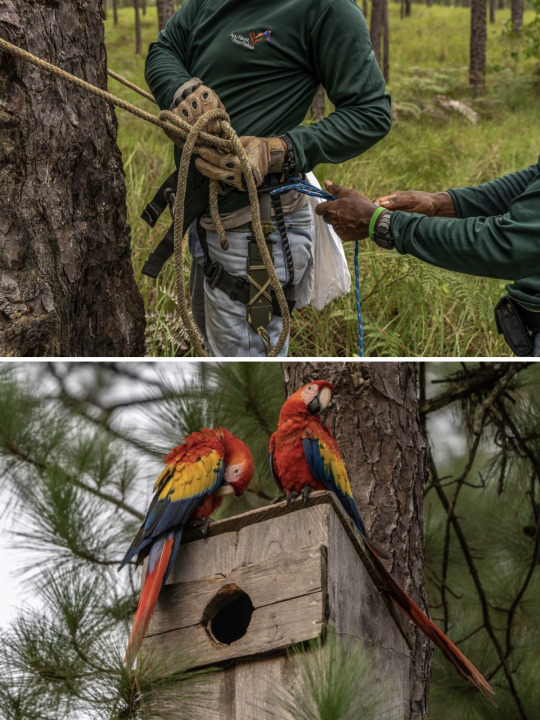
Top: Wesly Lacuth Pantin prepares to climb a towering pine tree where the scarlet macaws nest to determine whether the chicks had taken flight. Climbing trees is part of conservation efforts to protect the bird population by helping to conduct biological research. Bottom: Scarlet macaws atop a homemade wooden structure that serves as a nest attached to a pine tree in La Mosquitia. Community members have found that the homemade nests need to be placed more than one mile apart for the birds to use them.
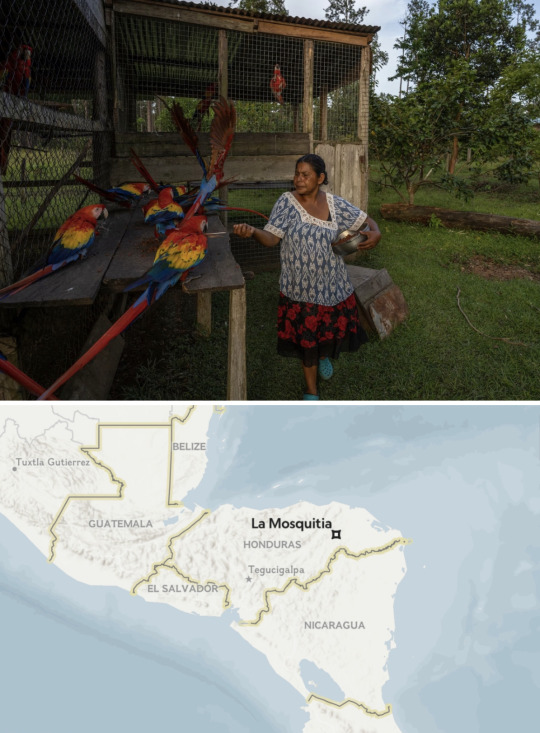
Top: Anayda Pantin Lopez feeds a small group of apu pauni, as the Indigenous Miskito people call the scarlet macaw. Conservation efforts have helped the bird population grow from 500 in 2010 to more than 800 today. "I take care of them with a lot of love,” says Pantin. “Seeing them sick or hurt makes me sad…I get very excited when I see them fly. It brings me a lot of joy." Bottom: Map
Twice a day, she prepares food for 40 to 60 macaws that come to her village for feedings. Pantin also cares for several other birds at a rescue center where birds retrieved from poachers, or chicks removed from their nests, are taken for care until they can fly freely again.
Years ago, her husband supported the family by planting beans, plantain, and yucca and by selling macaw eggs and fledglings as pets—not realizing it would have a detrimental impact on the bird population. When he learned the number of macaws was drastically declining, Lacuth decided to become a guardian of their nests. He confronted other poachers and tried to convince them to follow in his footsteps.
"They threatened me, but I held on to my thoughts to convince everyone to stop poaching the chicks,” says the community leader. “For many years the macaws helped me by selling them to be able to buy food for my family. Now it was my turn to help them."
Before 1990, the hunting and sale of wild species was legal and thousands of macaws disappeared, placing some of the animals at risk of extinction.

Top: Wesly Lacuth Pantin climbs a pine tree in La Mosquitia where the scarlet macaws nest. Since 2010, the Miskito community has joined forces with local and international organizations to protect the bird population from wildlife poachers. As a result, the bird protection and monitoring coverage area has grown from some 37,000 acres when the program began to nearly 990,000 acres today. Bottom: Nora Allen Dias poses for a portrait with her children in front of their home in La Mosquitia. The widow is among residents in the Mabita village who help care for the macaws as part of conservation efforts and to earn a living. “I have to do the work of men and women to create an income for my household,” she says.
Nesting on Pine Trees
The macaws who breed in this part of Honduras have a unique habit: they nest in towering pine trees. Elsewhere—from Mexico to parts of the Brazilian Amazon—these birds generally nest in tropical broadleaf forests where trees shed their leaves seasonally.
Héctor Portillo began visiting La Mosquitia more than 20 years ago to study the species. By 2010, his research determined that the scarlet macaw population had dwindled to 100 birds, compared to 500 in 2005.
Portillo’s work drew the attention of international organizations, such as the One Earth Conservation based in New York, which provided funds for a program to monitor and strengthen the macaw population with the support of Indigenous residents. Former poachers were paid about $10 per day to help care for the macaws and Panting was tapped to serve as the community’s project director.
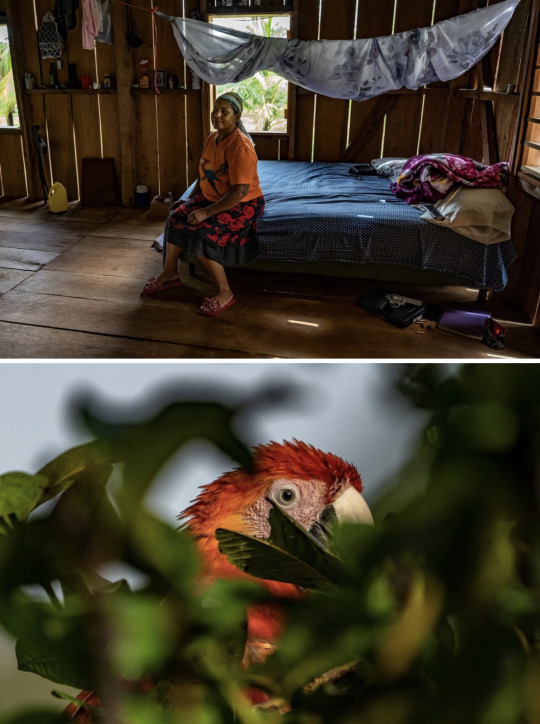
Top: Anayda Pantin Lopez poses for a portrait in her bedroom in La Mosquitia. She and her husband keep a rifle and a handgun within arm's reach due to the threat of attacks from poachers. Bottom: A scarlet macaw, the national bird of Honduras, perches on a tree in La Mosquitia, which has the largest wilderness area in Central America. It is the only place in the country where scarlet macaws fly freely.
“[As an organization] we are all over the Americas, but the Mabita project is one of the most compelling we know because of the commitment of Pantin and Lacuth, and the entire community,” says LoraKim Joyner, founder of One Earth Conservation.
During the first patrols, Lacuth and his brother recovered seven baby macaws, which he then took home to be cared for by his wife. Pantin immediately took on the role of cook, nurse, and surrogate mother while the birds learned how to fly. "She makes them live,” Lacuth says. “Not everyone can do that."
Despite having their own family to feed, including six children and other young relatives, the couple opted to share some of their crops with the birds. "It is vital to take care of them,” Pantin says. “Sometimes food is scarce, but we always do our best so that they have something to eat."

Top: In this archival image, a biologist examines a day-old scarlet macaw chick that is part of a breeding program in Central America. In Honduras, residents of the Miskito community have learned how to handle the chicks, how to measure them, weigh them, and document the information for later analysis as part of conservation efforts. Photograph By Kent Gilbert, AP. Bottom: Anayda Pantin Lopez walks toward a cage to feed wild scarlet macaws at a rescue center in La Mosquitia, Honduras where birds retrieved from poachers, or chicks removed from their nests, are taken for care until they can fly freely again. Photograph By Alejandro Cegarra
Between November and May of each year, macaws lay between two and four eggs. The chicks are born with their eyes sealed shut and sparsely feathered. During their first 10 weeks, both parents care for the chicks, feeding them four to six times a day. The young take between 40 to 45 days to reach their maximum size, and 10 to 16 weeks to fly and learn how to feed themselves.
Mabita's inhabitants didn't know the harmful impact of extracting baby macaws from their natural environment. "In this region we don't see much money. Before 2010, the only way to get it was by selling the macaws," says Lacouth, the former poacher turned conservationist. "Seeing that they were disappearing, I decided, together with the community, to protect them. The macaws helped me survive, and now it's my turn to help them."
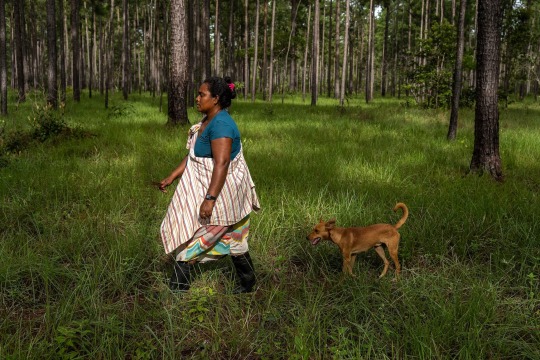
Nora Allen Dias participates in a patrol to assess the condition of scarlet macaw nests in the forest of La Mosquitia. It is part of a program to monitor and strengthen the macaw population with the support of Indigenous Miskito residents.
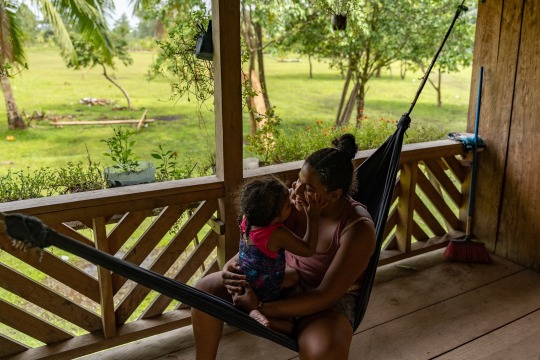

Top: Gabriela Lacoth Sudia plays with her daughter, Luna, on the porch of a house in La Mosquitia on the northeast corner of Honduras—home to the largest wilderness area in Central America. Bottom: Nora Allen Dias, Janneth Sanchez, and Mirsa Lacoth Jackson take a break during a patrol to inspect scarlet macaw hatchlings in a nearby nest in La Mosquitia, Honduras. Since 2010, local and international organizations have worked with area residents to protect the bird population from poachers. Before 1990, the hunting and sale of wild species was legal and thousands of macaws disappeared, placing some of the animals at risk of extinction.
Other Mabita residents joined Lacuth and Pantin’s effort, switching from extracting the chicks from their nests to climbing trees to help conduct biological research. Residents learned how to handle the chicks, how to measure them, weigh them, and document the information for later analysis.
"I liked having parrots in my house as pets, but Dr. LoraKim explained to us about the importance of these birds for nature and why they should be free," says Celia Lacoth, the community’s only teacher.
In 2014, additional funds came form the United States Fish and Wildlife Service (USFWS) and England's Darwin Foundation also stepped in to support the conservation and community engagement efforts. These resources helped to systematize the documentation process and mark trees with macaw nests using GPS points. The protection and monitoring coverage area grew from some 37,000 acres in 2010 to nearly 990,000 acres today.
"Thanks to this, we have been able to learn about the conservation status of biodiversity in almost the entire Mosquitia region," says Portillo.
Hazy Future
Since the project began, the scarlet macaw population has grown from 500 to more than 800. However, there is concern the progress made thus far will suffer a setback: funding for the community involvement program ended in June 2022.
But other programs are underway to help keep track of the animals. A center was built to teach visitors about the macaws and the Honduran government has pledged to create a “green battalion” within the army to keep poachers away, ward off drug traffickers, and prevent illegal logging that would harm where the birds nest.

Colorful scarlet macaws fly toward pine trees in La Mosquitia, Honduras where they nest. Elsewhere—from Mexico to parts of the Brazilian Amazon—these birds generally nest in tropical broadleaf forests where trees shed their leaves seasonally.
Meanwhile, members of the Miskito community have vowed to continue to protect the country’s national bird.
"Now we have seen that the number of birds has increased,” says Pantin. “But that does not change our goal, which is to continue caring for them so that our children and grandchildren have the opportunity to enjoy everything that nature gives us.”
— Photographer Alejandro Cegarra is based in México City. He photographed macaws in his native Venezeia in 2022. Based in Guatemala, Jorge Rodríguez is a new contributor to National Geographic.
0 notes
Text
‘It was my turn to help them’
New Post has been published on https://petn.ws/m1aJz
‘It was my turn to help them’
La Mosquitia, HondurasIt’s 4:30 in the morning. Behind a pine forest, the sun begins to lighten the sky with bright and warm tones, accompanied by the squawks of a small group of apu pauni, as the Indigenous Miskito people call the scarlet macaw. The colorful feathered creatures, the country’s national bird, groom each other as […]
See full article at https://petn.ws/m1aJz
#BirdNews
0 notes
Text
Paragraphs about Nicaragua
Students:
Elsner Fernández
Dereck Tijerino
José Antonio Baca
Luis Fernando Morales
First paragraph following the structure of page 71
Nicaragua is a beautiful country in the center of America, it is a country between the Atlantic Ocean in the west and the Pacific Ocean and the Caribbean Sea in the east, our nears neighbors are Honduras in the north, and in the south with Costa Rica, Another important fact is that the population of Nicaragua is approximately about 6,500 million. There is just one official language but also some people in the Caribbean coast and other parts of the country, they speak in different dialects like Miskito, Mayagna, and something called ingles creole. The capital city is Managua and the flag is white with blue. The special about Nicaragua are its beaches in the pacific and the Caribbean, its lakes and volcanos, and the beautiful people.
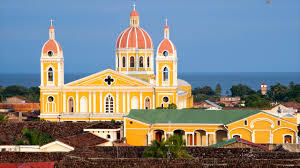
The second paragraph following the structure of page 70
Nicaragua.
Nicaragua is located in central America, it´s a beautiful country, there are a lot of lakes and mountains and volcanos, also beaches, with abundance of tropical birds, its landscapes are wonderful, the lakes Cocibolca and Xolotlán are the most representatives of de country. The Cocibolca is a lake of sweet water with an extension of 8,264 km², is one of the biggest of Central America. The volcanos are also an attractive point, there are active an inactive, also extinct. The Cerro negro volcano is very visited because the tourists can practice sandboarding there. In my country we can find places to take the best vacation in your life, much people from other countries come here, to spend time in the beaches, islands and colonial cities. The bigger city in Nicaragua for its geographic position is Jinotega and one of the most visited is Granada, and also Leon city. In our country we can enjoy all its cultural attractions and amazing landscapes.
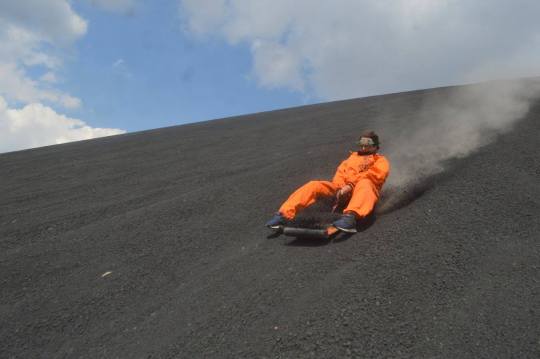
0 notes
Photo
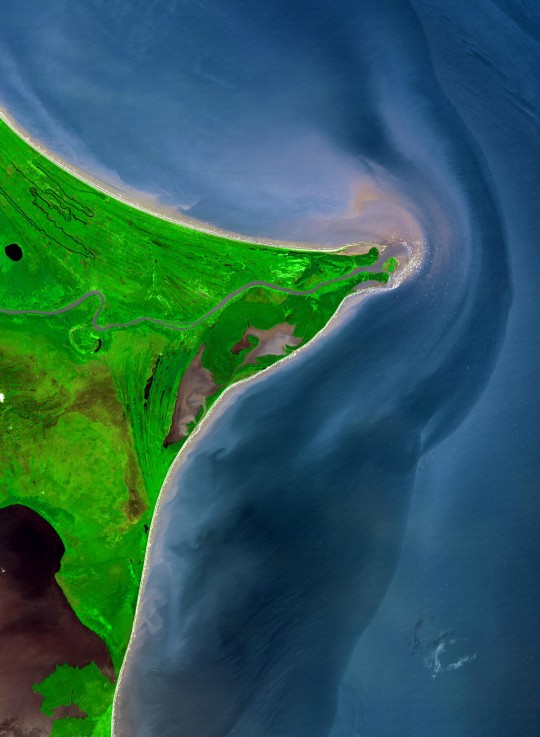
The Mosquito Coast (Honduras, December 2002), taken from NASA's Terra satellite.
The region surrounding the point of land jutting out into the Caribbean Sea is known as the Mosquito Coast, named after the Miskito people. It includes part of Honduras (north) and Nicaragua (south), with the Coco River between them, emptying into the Caribbean Sea at Cabo Gracias a Dios.
Vegetation appears as various shades of green, and the beaches as a light tan colour. The shades of blue and purple in the water may be due to water clarity, with clear, calm water in inland lakes and pools appearing deep blue, and rougher waters appearing greyish and purple.
South of the Coco River, near the centre left edge of the photo, a meander (deep band) in the river has been cut off from the main channel over time, and is filling with vegetation. It appears as a bright green semicircle.
North and south of the river, the land has a streaked appearance in some places, from relic shorelines.
#geography#potamology#astronomy#photography#rivers#native americans#miskito people#honduras#nicaragua#mosquito coast#coco river#cabo gracias a dios#caribbean sea
6 notes
·
View notes
Photo
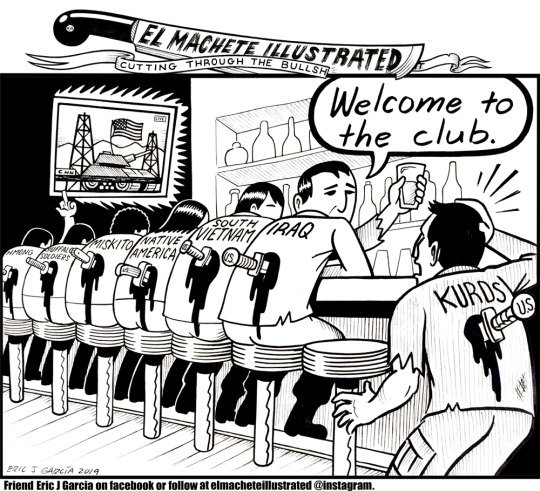
Welcome to the club
#kurds#kurds betrayed#USA#US Military#backstabers#back stab#south vietnam#native america#Iraq#Buffalo Soldiers#Miskito People#Nmong#oil#Priority is OIL
16 notes
·
View notes
Photo

In 1667, pirate Captain Francois Lolonois embarked on an expedition to sack Nicaragua with over seven hundred pirates enlisted, during which he came upon a shocking discovery at the islands of De las Pertas in Nicaragua.
Among their numbers was buccaneer Alexandre Exquemelin who afterwards in 1678 release his first edition of the “Buccaneers of America” detailing his time with them and is widely regarded as an important source material for 17th century pirate history. Within, he details that as part of the journey the pirates ran aground to the islands of De las Pertas, not far from the cape of Gracias a Dios, where he details the ‘savage natives’ there (Indiginous Miskitos); how they were tall and nimble, and carried no bows or arrows, but instead wielded wooden lances.
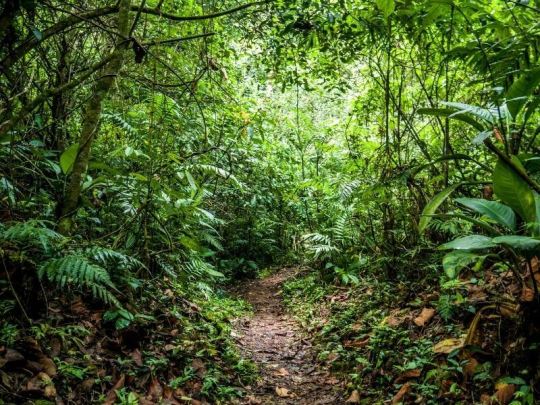
According to rumors Exquemelin had heard, they were also cannibals, a rumor he states was confirmed by Lolonois during their time there. While there, Lolonois had been accompanied by two companions while heading inland, one of them a Frenchman, the other a Spaniard. Within the island they were pursued and forced to fight the natives with their swords before being forced to flee. The Spaniard however was subdued and Lolonois had made the call to leave him behind and return for him.
A day or two later, Lolonois and eleven others embarked back inland on a rescue mission. Where they had fled from, the pirates discovered remnants of a campfire left by the natives, and at a small distance away they found a man’s bones ‘well roasted.’ Flesh had been poorly scraped off, yet one of the man’s hands had two fingers remaining. The rescue mission was called off, determining the remains to be of the poor Spanish crewmate.
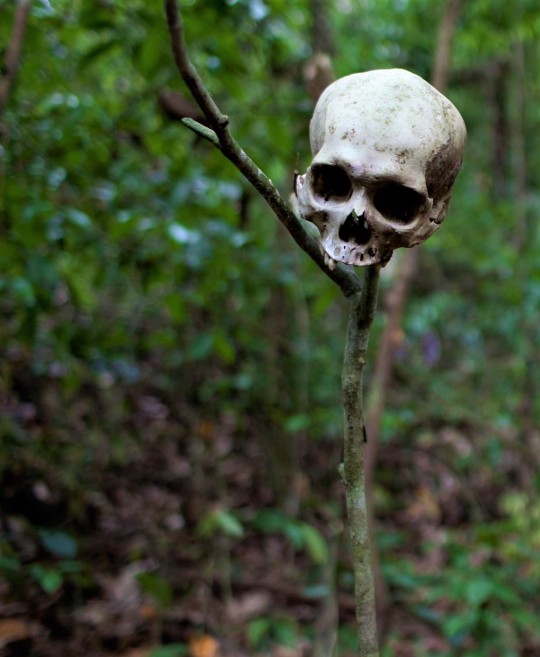
The pirates did push on in search of the natives however, now in stronger numbers, and came upon a collection of the natives (five men, four women) who they overpowered and held hostage for a time on their ships. The natives would give the pirates trinkets, knives, and beads as offerings of surrender. With nothing more to gain from them, the natives were released and signed that they would never come again.(Pictured is a section of the coast of Isla San Pio
[one of the islands the pirates called De las Pertas], and a human skull discovered within the the island of Malekula Island)
Please note that these are not my own opinionated views on the indigenous peoples of Honduras and Nicaragua, but simply an article on the report given by Alexandre Exquemelin in 1684.
#pirate#pirates#Buccaneers#Bucaneering Age#island#honduras#nicaragua#islands#natives#17th century#history#pirate history#bones
36 notes
·
View notes
Photo
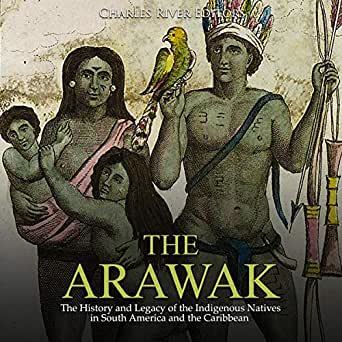
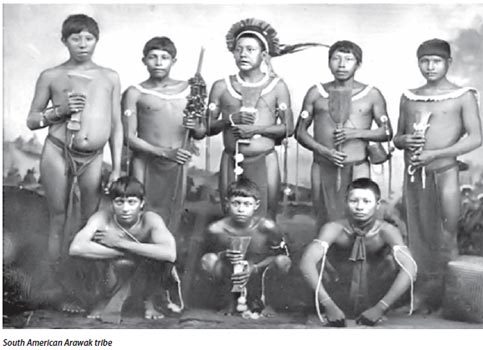


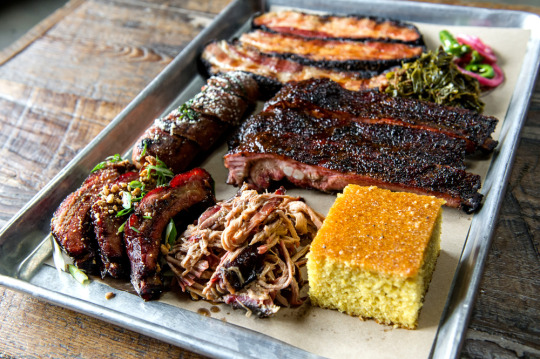
The English word "barbecue" and its cognates in other languages come from the Spanish word barbacoa. Etymologists believe this to be derived from barabicu found in the language of the Arawak people of the Caribbean and the Timucua people of Florida;it has entered some European languages in the form of the aforementioned barbacoa. The Oxford English Dictionary (OED) traces the word to Haiti and translates it as a "framework of sticks set upon posts". Gonzalo Fernández De Oviedo y Valdés, a Spanish explorer, was the first to use the word "barbecoa" in print in Spain in 1526 in the Diccionario de la Lengua Española (2nd Edition) of the Real Academia Española. After Columbus landed in the Americas in 1492, the Spaniards apparently found Taíno roasting meat over a grill consisting of a wooden framework resting on sticks above a fire. The flames and smoke rose and enveloped the meat, giving it a certain flavor.

Traditional barbacoa involves digging a hole in the ground and placing some meat—usually a whole lamb—above a pot so the juices can be used to make a broth. It is then covered with maguey leaves and coal, and set alight. The cooking process takes a few hours. Olaudah Equiano, an African abolitionist, described this method of roasting alligators among the Mosquito People (Miskito people) on his journeys to Cabo Gracias a Dios in his narrative The Interesting Narrative of the Life of Olaudah Equiano.
Linguists have suggested the word was loaned successively into Spanish, then Portuguese, French, and English. In the form barbacado the word was used in English in 1648 by the supposed Beauchamp Plantagenet in the tract A description of the province of New Albion: "the Indians in stead of salt doe barbecado or dry and smoak fish".According to the OED, the first recorded use in modern form was in 1661, in Edmund Hickeringill's Jamaica Viewed: "Some are slain, And their flesh forthwith Barbacu'd and eat";it also appears in 1672 in the writings of John Lederer following his travels in the North American southeast in 1669–70.First known use as a noun was in 1697 by the English buccaneer William Dampier. In his New Voyage Round the World, Dampier wrote, " ... and lay there all night, upon our Borbecu's, or frames of Sticks, raised about 3 foot from the Ground".
Samuel Johnson's 1756 dictionary gave the following definitions:
"To Barbecue – a term for dressing a whole hog" (attestation to Pope)
"Barbecue – a hog dressed whole"
While the standard modern English spelling of the word is barbecue, variations including barbeque and truncations such as bar-b-q or BBQ may also be found.The spelling barbeque is given in Merriam-Webster and the Oxford Dictionaries as a variant. In the southeastern United States, the word barbecue is used predominantly as a noun referring to roast pork, while in the southwestern states cuts of beef are often cooked

497 notes
·
View notes
Text
We thought it would be enough to tell of the tidal wave of hatred that broke over the Jewish people, to have men everywhere decide once and for all to put an end to hatred of anyone who is “different”—whether black or white, Jew or Arab, Christian or Muslim—anyone whose orientation differs politically, philosophically, sexually. A naïve undertaking? Of course. But not without a certain logic.
We tried. It was not easy. At first, because of the language: language failed us. We would have to invent a new vocabulary, for our own words were inadequate, anemic.
And then, too, the people around us refused to listen; and even those who listened refused to believe; and even those who believed could not comprehend. Of course they could not. Nobody could. The experience of the camps defies comprehension. Can you understand, can anyone understand, how a nation of such culture, of such power, could all of a sudden invent death camps, death factories, and mobilize its entire industry, its science, its philosophy, its passion, to kill Jewish people? For what? I cannot understand; even from their viewpoint it was madness. In 1944, when they were losing the war, they gave priority to trains leading Jews to their deaths over military trains bringing soldiers and weapons to the front. That doesn’t make sense. But it was going on to the very last day. Wouldn’t the story of their irrational criminal behavior prevent irrational crimes against humanity elsewhere?
So we tried. Perhaps if we were to tell the tale things would change. Have we failed? I often think we have. If someone had told us in 1945 that in our lifetime religious wars would rage on virtually every continent, that thousands of children would once again be dying of starvation, we would not have believed it. Or that racism and fanaticism would flourish once again. Nor would we have believed there would be governments that would deprive men and women of their basic rights merely because they dared to dissent. Governments of the right and of the left still subject those who dissent—writers, scientists, intellectuals—to torture and persecution. How is one to explain all this unless we consider the defeat of memory?
How is one to explain any of it? The outrage of apartheid, which continues unabated? Racism in itself is dreadful, but when it pretends to be legal, and therefore just, it becomes even more repugnant. Without comparing apartheid to Nazism and to its “Final Solution”—for that defies all comparison—one cannot help but assign the two systems, in their supposed legality, to the same camp.
... And here we come back to memory. We must remember the suffering of my people, as we must remember that of the Ethiopians, the Cambodians, the Boat People, the Palestinians, the Miskito Indians, the Argentinian “desaparecidos”—the list seems endless.
There may be times when we are powerless to prevent injustice, but there must never be a time when we fail to protest.
Night - Elie Wiesel
#night#און די וועלט האָט געשוויגן#Un di Velt Hot Geshvign#And The World Remained Silent#La Nuit#the night trilogy#Elie Wiesel#Marion Wiesel#François Mauriac#Barack Obama#holocaust#nonfiction#atypicalreads#history#autobiography#memoir#concentration camp#Jewish history#genocide#buchenwald#auschwitz#world war ii#world war 2#war#sad#cw negative#cw death#cw destruction#cw nazi#reading
5 notes
·
View notes